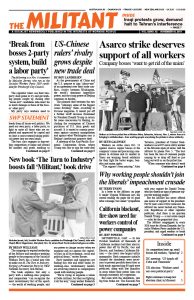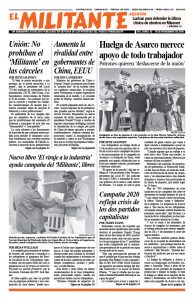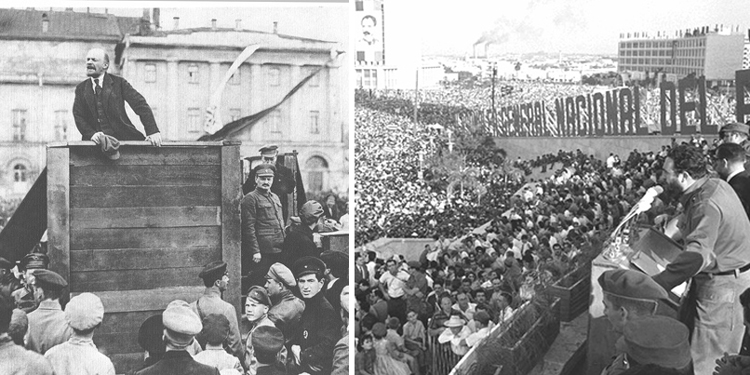Their Trotsky and Ours by Jack Barnes, national secretary of the Socialist Workers Party, is one of Pathfinder’s Books of the Month for November. Based on his 1982 speech, it explains that to lead a successful working-class revolution, a mass proletarian party is needed whose cadres have absorbed an internationalist communist program, whose life and work are rooted in the working class, who derive deep satisfaction from doing politics and have forged a leadership with an acute sense of what to do next. The excerpt below is from the chapter “Marxism, Bolshevism, and the Communist International.” Copyright © 1983 by Pathfinder Press. Reprinted by permission.
Our revolutionary political continuity, that of the modern working class, does not go back very far — only 135 years. It goes back to the generalizations adopted by the Communist League and presented in initial form in its manifesto, which [Karl] Marx and [Frederick] Engels were assigned to draft, and in its organizational rules, which they also had a major role in preparing.
The lessons drawn by the leaders of the Cuban, Nicaraguan, Salvadoran, and Grenadian revolutions are part of this common revolutionary continuity. But determining just what, concretely, that consists of is a little more complicated than it might seem. Because political continuity is not like the doctrine of a church, which is ultimately judged right or wrong by some body of people who claim a direct line to someone or something you can’t argue with. That is how the articles of a faith are settled.
But as Engels wrote just two months before the formation of the Communist League at the end of 1847, “Communism is not a doctrine but a movement; it proceeds not from principles but from facts. … Communism, insofar as it is a theory, is the theoretical expression of the position of the proletariat in this [class] struggle and the theoretical summation of the conditions for the liberation of the proletariat.”
Communists don’t have any articles of faith. What we have, as Engels explained, is simply the political generalizations and strategic lessons from the experiences of a class that has been marching toward taking power ever since it was born and began to wage battles in its own name — the modern working class. …
It is only by generalizing and drawing the lessons of the actual experiences of the working class that revolutionists develop a program and strategy that can help us lead our class toward that goal — the dictatorship of the proletariat. That is where our political continuity comes from.
Lenin said that without revolutionary theory, there can be no revolutionary movement. You hear that quotation so many times that it can sometimes lose its meaning. But it is important to think about what Lenin actually said. He didn’t say that without revolutionary theory there can be no revolutionary action. That would be wrong. Horribly and disarmingly so. There can be, have been, and will continue to be revolutionary struggles by working people that are not guided by organizations equipped with revolutionary theory. Revolutionary struggles, but not a revolutionary movement. Because building a revolutionary movement, as opposed to action alone, necessitates a conscious generalization of lessons that our class has learned through struggle into a program and strategy, a political continuity, upon which revolutionary organization is based.
These lessons — what to do, and in some ways even more importantly, what not to do — have been paid for in blood many times over by our class. They are irreplaceable.
The fact that our program and strategy are rooted in the experience of the working class, however, also means that new experiences change, better enrich, our revolutionary continuity. They cannot alter past events, of course. But our political continuity is not frozen. It is the evolving consciousness of the vanguard of a class, expressed in program and strategy and embodied in revolutionary organizations and their cadres.
We incorporate new lessons while preserving old ones and understanding them in new ways. Our revolutionary continuity is a living thing. It is our current understanding of the rich lessons of revolutions and class battles that came before us, and this understanding changes as our class goes through new experiences.
The program of the Communist International was not only in continuity with but also far richer and more extensive than the program of the pre-World War I Bolshevik Party, for example. The world proletariat had gone through the first imperialist world war, the collapse of the Second International as a revolutionary organization, and the 1917 Russian Revolution. These events, culminating in the establishment of the world’s first workers state, had put all wings of the workers movement to the test. The Third International didn’t just preserve what was best from the program of its forerunners, what had stood the test of titanic events. It also made additions and altered the weight and emphasis it gave to various aspects of this program.
Similarly, [with] the Cuban Revolution … these experiences enrich and change the way we understand and apply our revolutionary continuity today. If new socialist revolutions didn’t affect us this way, we would be finished as a revolutionary organization.
Questions that couldn’t be answered definitively twenty-five years ago have been settled by the class struggle. For example, were all revolutions going to be led — and warped — by parties trained in the school of Stalinism? That could have seemed to be the case during the period between World War II and late 1959. We were confident that the answer was “no,” but it was nonetheless an open question until it was settled in practice by the victory of the Cuban Revolution. …
But each generation of working-class fighters must see these lessons through its own eyes, from the standpoint of the concrete experiences it has gone through and anticipates. In that way, each generation understands its continuity more deeply, enriches it, uses those aspects that most directly relate to its own experiences.


